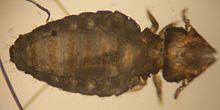Mallophaga
| Mallophaga | |
|---|---|

| |
| Felicola subrostratus | |
| Scientific classification | |
| Kingdom: | |
| Phylum: | |
| Class: | |
| Order: | |
| Suborder: | Mallophaga Nitzsch, 1818
|
Mallophaga is a suborder of lice, known as chewing lice, biting lice or bird lice, containing more than 3000 species. These lice are external parasites that feed mainly on birds although some species also feed on mammals. They infest both domestic and wild animals and birds and cause considerable irritation to their host.[1] They have paurometabolis or incomplete metamorphosis.[2][3]
Characteristics
There are approximately 3000 species of Mallophaga in the world. They are easily identifiable by their head, which is wider than the prothorax. The species that feed on birds typically have two claws on the end of each tarsus while those that feed on mammals typically have just a single claw.[1]
Mallophaga have mandibulate mouthparts which are located on the ventral side of their head. They use these mouthparts to feed on feathers, hair and epidermal skin scales. Some species also use these mouthparts to feed on blood which they obtain by piercing the pulp of young feathers or by gnawing through the skin.[1]
Life cycle
Mallophaga develop by gradual metamorphosis. Females will typically lay 150–300 eggs over an interval of 2–3 weeks. The eggs, commonly known as nits, are oblong and approximately 1 mm long. The eggs are glued to the hairs or feathers of the host with a secretion from the female accessory glands. The eggs typically hatch several days or up to three weeks from the time they are laid. The nymphs that hatch from the eggs resemble the adults except for their smaller size and lighter color. These nymphs go through three nymphal instars during a 2–3-week period. After these three instars, they are considered adults. Most adult species are light tan to brown in color and are usually 1–4 mm in length although some livestock species can grow to be 5–7 mm and some wild bird species can even get to 10 mm.[1]
Mallophaga are often adapted to live on a specific part of their host and typically spend their entire lives on a single host. They can only survive for about three days after their host has died and they typically use phoresis, which is hitching a ride from a fly, as an attempt to reach a new host. Mallophaga may also use phoresis in order to spread to a new host even if the present one is still alive.[4]
References
- ^ a b c d D.E. Bay & R.L. Harris (1988). Introduction to Veterinary Entomology (A Guide to Livestock Insects). [ [Robert Harris Publisher] ]. ISBN 0-9624083-0-1.
- ^ Frank N. Young & Gene Kritsky (2002). "The Hemipteroidea". A Survey of Entomology. iUniverse. pp. 178–191. ISBN 978-0-595-22143-1.
- ^ Cyrus Abivardi (2001). "Destructive and useful insects". Iranian Entomology: an Introduction. Springer. pp. 563–902. ISBN 978-3-540-67592-1.
- ^ Ramel, Gordan. "The Biting Lice (Mallophaga)". Gordon's Mallophaga (Biting Lice) Page. N.p., n.d. Web. 31 Mar. 2013.
